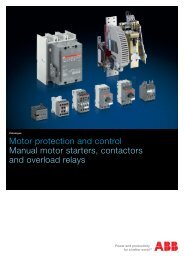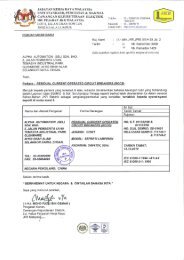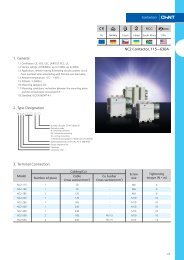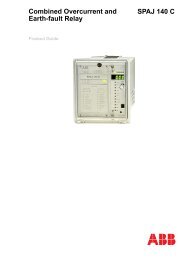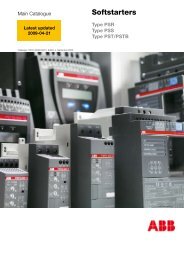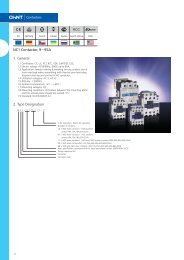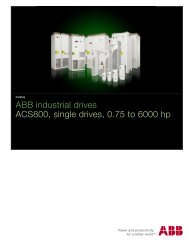Emax Low voltage air circuit-breakers - ABB Download Center
Emax Low voltage air circuit-breakers - ABB Download Center
Emax Low voltage air circuit-breakers - ABB Download Center
Create successful ePaper yourself
Turn your PDF publications into a flip-book with our unique Google optimized e-Paper software.
Line protectionThe following main parameters must be known in order to make the correct choice of <strong>circuit</strong><strong>breakers</strong>for line operation and protection:– operating current of the line l b– permanent current-carrying capacity of the conductor l z– section S and cable insulation material, with relative constant K– short-<strong>circuit</strong> current I kat the point of installation of the <strong>circuit</strong>-breaker.The protection device selected must offer a breaking capacity (Icu or Ics at the system <strong>voltage</strong>)higher than or equal to the short-<strong>circuit</strong> value at the application point. The operating characteristicsof the device selected must also meet the following conditions:Overload protectionI b≤ I n≤ I zNoteWith regard to the verification required bythe IEC 60364-4-43 Standards, whichprescribe that the overload protection musthave a trip current I 2ensuring effectiveoperation of the device at a value lowerthan 1.45 I z(I 2< 1.45 I z), this is alwayssatisfied since SACE <strong>Emax</strong> <strong>circuit</strong>-<strong>breakers</strong>comply with the CEI EN 60947-2 Standardsand this value is 1.3 I n.I f≤ 1.45 I zwhereI bis the operating current of the <strong>circuit</strong>;I zis the permanent current-carrying capacity of the conductor;I nis the adjusted rated current of the protection device;is the current that ensures effective operation of the protection device.I fThe above inequalities are easily respected thanks to the wide setting ranges offered by thePR121-PR122-PR123 trip units.Short-<strong>circuit</strong> protectionAssuming that a conductor overheats adiabatically during the passage of the short-<strong>circuit</strong> current,the following formula must be verified:(I 2 t) <strong>circuit</strong>-breaker≤ (K 2 S 2 ) cabletherefore the specific let-through energy (I 2 t) of the <strong>circuit</strong>-breaker must be lower than or equal tothe specific let-through energy (K 2 S 2 ) withstood by the cable.6Also make sure that the <strong>circuit</strong>-breaker trips within the limits prescribed by the internationalstandards regarding the minimum value of the short-<strong>circuit</strong> current at the end of the line.The minimum short-<strong>circuit</strong> current is the current which corresponds to a short-<strong>circuit</strong> occurringbetween phase and neutral (or between phase and phase if the neutral conductor is not distributed)at the farthest point of the conductor.Protection against indirect contactsIn the event of a fault involving a phase and a part of the installation that is not normally live, it isbest to make sure that the <strong>circuit</strong>-breaker trips within the times prescribed by the internationalstandards for current values lower than or equal to the fault current.Based on the value of this current, it is possible to intervene using function I of the trip unit,function G or, for extremely low values, the RCQ device.0.03 A 0.5 A 30 A 50 A 375 A 25200 ARCQFunction GExternal toroidResidual currentFunction I1SDC200204F0001The figure shows which function of the electronic trip unit or device to use on the basis of thefault current.6/30<strong>ABB</strong> SACE




